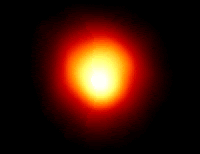IT HAPPENED 440 MILLION YEARS AGO!
Supernova caught in its exploding act
August 30, 2006
 Teams of international scientists have used observations from NASA's Swift satellite and other telescopes to witness the evolution of a cosmic blast into a stellar explosion or supernova. Teams of international scientists have used observations from NASA's Swift satellite and other telescopes to witness the evolution of a cosmic blast into a stellar explosion or supernova.The blast is thought to be a milder type of gamma-ray burst (GRB) -- the most powerful type of explosion known to astronomers -- called an X-ray flash. It is known as GRB060218 after the February 18 date it began in the constellation of Aries about 440 million light years away. A light year is about 6 trillion miles, the distance light travels in a year. "This extends the GRB-supernova connection to X-ray flashes and fainter supernovae, implying a common origin," said Elena Pian of Italy's National Institute for Astrophysics in Trieste and the lead author of one of four research papers about the event in the journal Nature on Wednesday. It is the second-closest gamma-ray burst ever detected and the first view of a supernova in the act of exploding, according to the astronomers. Pian and her group confirmed that the explosion was tied to a supernova called SN2006aj a few days after the outburst, which lasted 100 times longer than a typical gamma-ray burst but was much dimmer. Alicia Soderberg and her colleagues at the California Institute of Technology in Pasadena used radio and X-ray wavelengths to calculate that GRB060218 was about 100 times less energetic than ordinary GRBs but similar events are probably more common. In another report in the journal, Sergio Campana and scientists at the National Institute for Astrophysics observatory in Merate, Italy also said the collapsing star was associated with a supernova. X-ray flashes appear to signal an explosion that leaves behind a neutron star while gamma-ray bursts are thought to mark the birth of a black hole, a region of space from which nothing can escape. Scientists led by Paolo Mazzali, of the Max Planck Institute of Astrophysics in Garching, Germany found that the star had a smaller mass than those estimated for the normal GRB-supernova. "The properties of GRB060218 suggest the existence of a population of events less luminous than classical GRBs, but possibly more numerous," Mazzali said in a statement. In a commentary in the journal, Timothy Young of the University of North Dakota in the United States said the research has shown that at least some GRBs are warnings of the imminent explosion of massive stars. "All four papers make clear that the exploding object sent out both a slightly aspherical shockwave, typical of a supernova, and a jet-like stream of material characteristic of a GRB," he said. |
SOURCE

















<< Home